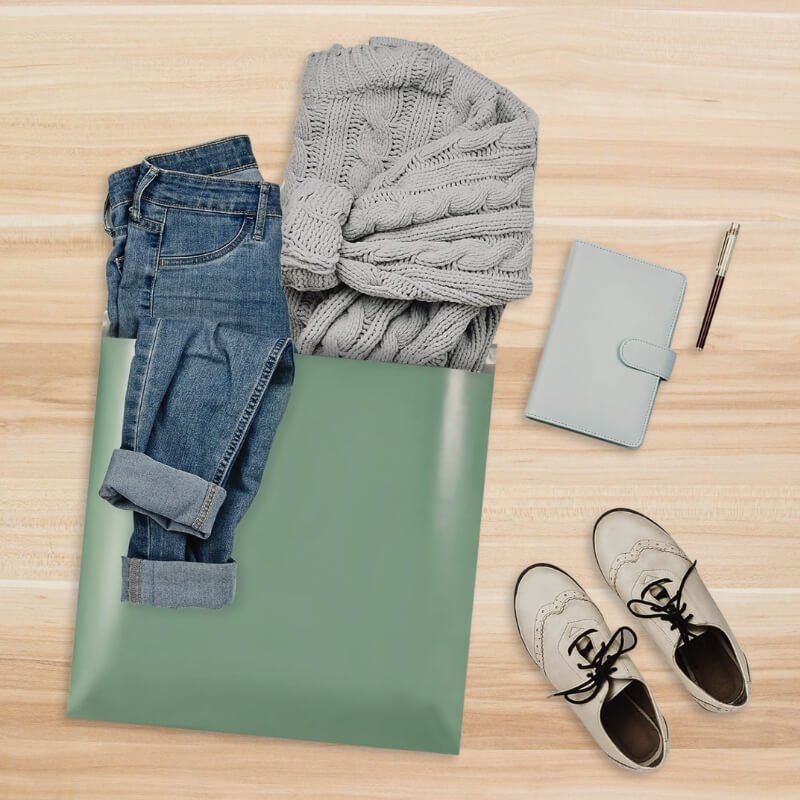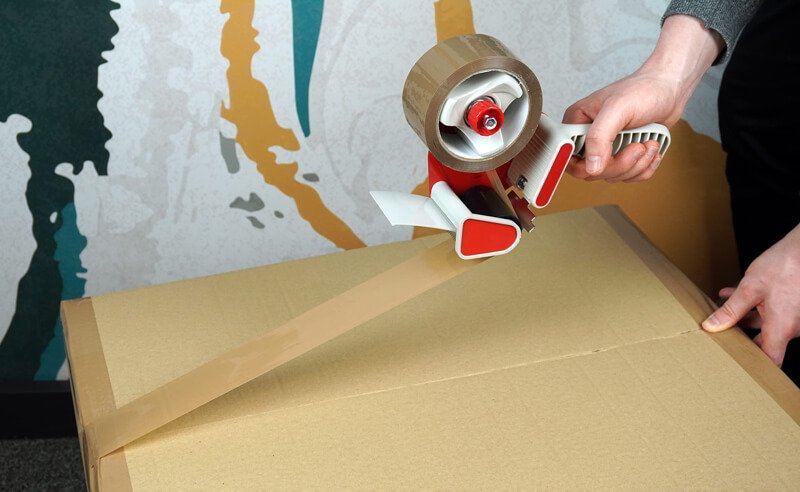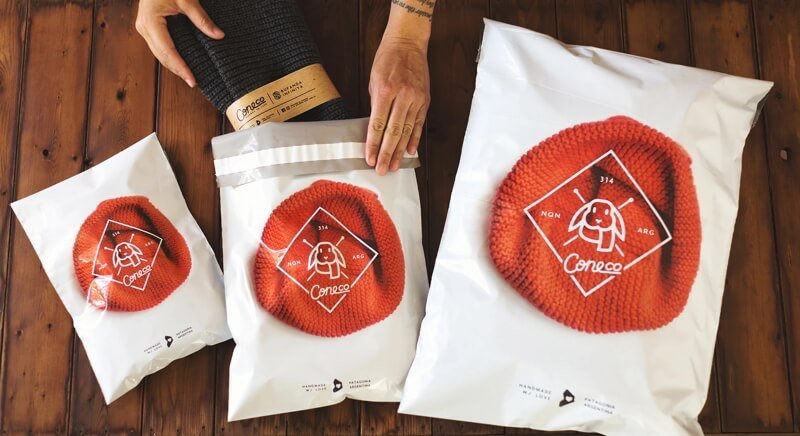Taping Poly Mailers Together: Rules, Tips and Alternatives
Shipping an item that’s too big for one poly mailer? Taping two together seems like a quick fix, but is it allowed? Will it hold? Are there better packaging alternatives? This guide tackles this common e-commerce dilemma, especially for small businesses.
Choosing the wrong packaging can lead to rejected packages, delays, damage and higher shipping costs. Learn the rules, the risks and the best practices for shipping oversized items. We’ll cover postal regulations, taping techniques (if you must) and, most importantly, superior alternatives like larger mailers and boxes. Make informed shipping decisions to protect your products and your bottom line.
1. The two-mailer conundrum – A common shipping dilemma
You’ve got an item ready to ship, but it’s just a bit too large or an awkward shape, for your standard poly mailers. The temptation arises: can you simply tape two poly mailers together to create a larger, custom-sized package? It seems like a convenient and potentially cost-effective shipping solution.
This is a common question and the answer isn’t a straightforward “yes” or “no.” It’s a situation that requires careful consideration of postal regulations, practicalities and potential risks. This guide will walk you through everything you need to know, when your item is too big for one mailer.

2. Is it allowed? Postal regulations and practicalities
2.1 The general rule: Technically yes, but with caveats
Generally speaking, major postal services like USPS, FedEx and UPS do not have explicit rules prohibiting the taping together of two (or more) poly mailers (or bubble mailers). This is fundamentally different from modifying Flat Rate packaging (which is strictly forbidden, as we’ll discuss below).
However – and this is a crucial “but” – the resulting combined package must still meet all other size restrictions, weight limits and security requirements of the chosen shipping service and shipping method. Taping mailers together isn’t a free pass to create a package of any size, shape or level of flimsiness. The postal service cares primarily about the package’s:
- Integrity: It must be securely sealed and able to withstand the rigors of handling and transit.
- Measurability: It must be easily measurable to determine the correct postage.
- Safety: It must not pose a hazard to postal workers or equipment.
Think of it this way: the postal service cares more about the integrity, measurability and safety of the package than the specific method you used to create it, as long as the final result meets their established shipping rules. Taping mailers together is a gray area – permissible with caution.
2.2 The Flat Rate exception: A definite no-go
While taping standard poly mailers together falls into a gray area, there’s one absolute rule: Never, ever try to modify, combine or alter Flat Rate packaging (boxes or envelopes) in any way. This applies to USPS Priority Mail Flat Rate packaging and likely to similar flat-rate services offered by other carriers.
The pricing for Flat Rate services is based on the specific, pre-approved dimensions of the provided packaging. Any attempt to tape together, cut down, expand or otherwise alter Flat Rate boxes or envelopes is strictly prohibited. Doing so will almost certainly result in:
- Package rejection: The postal service will refuse to accept the package.
- Postage due: You’ll have to repackage the item and pay for new postage, at the appropriate rate for the actual size and weight.
2.3 Size and weight limits: The key constraints
Even if taping mailers together is technically permissible in principle, the resulting combined package must still strictly adhere to the size and weight restrictions of the chosen shipping service and shipping method. These limits vary depending on the carrier and the specific service you select.
- USPS: For many USPS services, the maximum weight is 70 pounds and the maximum combined length and girth is 108 inches. However, these limits can vary, so it’s essential to check the current regulations on the USPS website (usps.com) for the specific service you’re using. Refer to USPS size restrictions.
- FedEx: FedEx has various size and weight limits depending on the service. Check fedex.com for details. Refer to Fedex size restrictions.
- UPS: UPS also has varying size and weight limits. Check ups.com for details. Refer to UPS size restrictions.
Dimensional weight: It’s also crucial to understand the concept of dimensional weight. This is a pricing technique used by carriers for larger, lightweight packages. The dimensional weight is calculated based on the package’s volume (length x width x height) and may be higher than the actual weight. If the dimensional weight is higher, you’ll be charged based on that, not the actual weight.
Consequences of exceeding limits: Exceeding size or weight limits (including dimensional weight) can result in:
- Significant extra fees (surcharges).
- Package rejection.
- Shipping delays.
- Be careful not to create a package that falls into the “oversized” category, which can incur extra fees.
Always measure and weigh your combined package after taping it together and use the carrier’s online shipping calculator to determine the correct postage.
3. Best practices: Taping poly mailers securely and effectively
If, after considering the alternatives (discussed later), you decide that taping poly mailers together is the only viable option for your specific situation, it’s crucial to do it correctly to maximize security and minimize the risk of problems.
3.1 Choosing the right tape: Strength and coverage are key
The tape you use is the single most important factor in determining the success of this method. Never skimp on tape!
- Strong packing tape: Use strong packing tape that’s specifically designed for shipping. This tape is typically at least 2 inches wide and has a strong adhesive.
- Reinforced packing tape: For added security, especially for heavier items or if you’re concerned about rough handling, consider using reinforced packing tape. This type of tape has fiberglass strands embedded in it, making it incredibly strong and tear-resistant. Fiberglass reinforced tape is the best.
- Avoid weak tapes: Never use masking tape, cellophane tape (Scotch tape) or painter’s tape. These tapes are not strong enough for shipping purposes and are likely to tear or detach, leading to package failure.
- Duct tape (consider carefully): Duct tape can be strong, but its adhesive can sometimes leave a residue on poly mailers and it may not adhere as well to some surfaces as packing tape. If you use duct tape, make sure it’s a high-quality brand and test its adhesion on a small area first.
The tape is the only thing holding your package together, so choose wisely and use it generously.

3.2 The overlapping technique: Maximizing strength and preventing tears
Simply butting the edges of two poly mailers together and applying a single strip of tape is a recipe for disaster. The key to creating a strong, secure connection is overlapping. Step-by-Step Instructions:
Align the mailers: Decide how you want to align the two (or more) mailers to best accommodate the item you’re shipping. You might align them:
- End-to-end: To create a longer mailer.
- Side-by-side: To create a wider mailer.
- Overlapping flaps: If the mailers have flaps, you can overlap them for added security.
- Consider the item inside and how to arrange the mailers for the best fit and protection.
Overlap the edges: Overlap the edges of the mailers by at least 2-3 inches and preferably more. The greater the overlap, the stronger the connection will be. This overlap provides:
- More surface area: For the tape to adhere to.
- Stress distribution: Prevents the tape from bearing the entire load at a single point.
Apply multiple strips: Use multiple strips of tape, both along the overlapped seam and perpendicular to it. This creates a grid pattern that reinforces the connection and prevents tearing. Imagine you’re creating a “tape fabric” that binds the mailers together.
Cover all edges and seams: Ensure that all open edges, seams and flaps are completely covered with tape. This prevents the mailers from:
- Snagging: On sorting equipment or other packages.
- Tearing open: During transit.
Smooth the tape: Press down firmly on the tape with your hands or a tape dispenser to ensure good adhesion to the poly mailer material. Remove any air bubbles to create a tight seal. This ensures the tape is securely applied.
Think of it like bricklaying or shingling a roof. Overlapping the edges and using multiple strips of tape creates a much stronger and more secure connection than simply butting the edges together and using a single strip.
3.3 Protecting the contents: Internal padding is crucial
Even if the item you’re shipping isn’t particularly fragile, it’s highly recommended to use some form of internal padding when taping poly mailers together. This serves two important purposes:
- Prevent shifting: Padding prevents the item from shifting around inside the combined mailers during transit. Shifting can put stress on the taped seams and increase the risk of the package tearing open.
- Cushioning and protection: Padding provides cushioning and protects the item from impacts, bumps and drops during handling.
Suitable padding materials include:
- Bubble wrap: Excellent for cushioning fragile items.
- Packing peanuts: Fill voids and prevent shifting (though some consider them environmentally unfriendly).
- Crumpled paper: A readily available and inexpensive option.
- Air pillows: Lightweight and provide good cushioning.
Choose a padding material that’s appropriate for the item you’re shipping and provides adequate protection.
3.4 Labeling clearly: Ensuring delivery and avoiding problems
Proper labeling is essential for any package, but it’s especially important when you’ve created a custom package by taping mailers together.
- Flat surface: Place the shipping label on a flat, smooth surface of the combined mailer. Avoid placing it over seams, tape or any areas where it might be difficult to scan or read.
- Clear and secure: Make sure the label is completely legible and securely attached.
- Protection: Consider using a clear label protector (a plastic sleeve) or covering the entire label with clear packing tape to prevent smudging, tearing or water damage. This is especially important if the label is printed on plain paper.
- Barcode visibility: Ensure the barcode on the shipping label is completely visible and unobstructed for easy barcode scanning.
A poorly placed or damaged address label can lead to delays or even misdelivery.
4. Potential problems and pitfalls: Risks of taping mailers
While taping poly mailers together can be done in a pinch, it’s crucial to be aware of the potential problems and risks:
4.1 Irregular shape: Handling challenges and potential delays
A package created by taping two or more mailers together will almost certainly have an irregular shape. This can create several challenges:
- Handling difficulties: Postal workers may find it more difficult to handle and sort an irregularly shaped package.
- Sorting problems: Automated sorting equipment is designed to handle standard-shaped packages. An irregular package may not fit through the machinery properly or can be hard to sort in the mail stream, leading to delays or manual sorting (which also takes more time).
- Potential delays: Due to handling and sorting difficulties, irregularly shaped packages are more likely to experience shipping delays.
- Increased risk of damage: Irregular shapes are more prone to getting caught on machinery or snagged during transit, increasing the risk of damage to the package and its contents.
4.2 Weak points: Risk of tearing or separation in transit
The taped seam where the mailers are joined is a potential weak point, even with careful taping. This is especially true if:
- The tape isn’t strong enough: Using weak tape (like masking tape) is a major risk.
- The tape isn’t applied correctly: Insufficient overlap, not enough strips of tape or not covering all edges can compromise the seam’s strength.
- The package is subjected to rough handling: The stresses of shipping (being tossed around, stacked under other packages, etc.) can put significant strain on the taped seam.
If the package tears or comes apart during transit, the contents could be lost or damaged, causing package failure.
4.3 Appearance: Professionalism matters (especially for businesses)
A package made of taped-together mailers may look unprofessional and less secure, which could be a significant concern for businesses shipping to customers. It can create a negative impression of the sender’s brand and may lead customers to question the quality of the products inside.
While taping mailers together might be acceptable for personal shipments between friends and family, it’s generally not recommended for business use, where professionalism and brand image are important.

5. Alternatives to taping: Better packaging options
Given the potential problems and risks associated with taping poly mailers together, it’s always best to explore alternative packaging solutions. In most cases, a better option exists.
5.1 The right-sized poly mailer: The ideal solution
Whenever possible, the best solution is to use a single poly mailer that’s appropriately sized for the item you’re shipping. This is:
- The simplest approach.
- The most secure option.
- The most professional-looking.
- Generally, the best way to comply with postal regulations.
Poly mailers come in a wide variety of sizes, from small (e.g., 6 x 9 inches) to very large (e.g., 24 x 36 inches or even larger). There are also different types of poly mailers designed to accommodate various item shapes and sizes:
- Standard flat poly mailers: These are best for flat or thin items, like clothing, documents or books.
- Bubble-lined poly mailers: These provide extra cushioning for items that need protection from impacts.
- Gusseted poly mailers: These mailers have expandable sides (gussets) that allow them to accommodate thicker or bulkier items, acting as an expandable mailer.
Measure your item (length, width and thickness) and choose a poly mailer that provides a little extra room for padding, but isn’t excessively large.
5.2 Boxes: For larger, heavier or fragile items
If your item is too large, too heavy or too fragile for even the largest poly mailer, a cardboard box is the best alternative. Shipping boxes offer:
- Superior protection: They are much more rigid and sturdy than poly mailers, providing better protection against impacts, crushing and bending.
- Better for fragile items: Boxes, combined with appropriate padding, are essential for shipping fragile items that could be easily damaged.
- More professional appearance: For businesses, boxes often convey a more professional image than poly mailers.
- They offer superior structural integrity.
Choose a cardboard box that’s appropriately sized for your item, allowing for sufficient padding around all sides.
5.3 Custom packaging
If you frequently ship items of a particular size or shape that doesn’t fit well into standard packaging, consider investing in custom packaging. While this involves a higher upfront cost, it can save you money in the long run and improve your brand image.

6. FAQs about taping poly mailers together
6.1 Will USPS/FedEx/UPS reject my package if I tape two poly mailers together?
Generally, no, they will not automatically reject a package simply because it’s made of two (or more) poly mailers taped together, as long as the resulting package meets all of their size, weight and security requirements and it’s not a modification of Flat Rate packaging.
However, an improperly taped package that is flimsy, irregularly shaped, has a poorly secured label or is otherwise deemed unsafe or unmailable is more likely to be rejected or delayed. It’s ultimately at the discretion of the postal worker or sorting facility.
6.2 What’s the best type of tape to use when taping poly mailers?
The best type of tape is strong packing tape that’s specifically designed for shipping. This tape is typically at least 2 inches wide and has a strong adhesive. Reinforced packing tape (with fiberglass strands) is even better for added strength and security. Avoid using weak tapes like masking tape or cellophane tape.
6.3 Can I tape two Flat Rate envelopes or boxes together?
Absolutely not! Modifying or combining Flat Rate packaging in any way is strictly prohibited and will result in your package being rejected.
6.4 Is it cheaper to tape two smaller mailers together than to use a larger one?
Not necessarily. While you might save a small amount on the initial cost of the mailers, consider:
- The cost of the tape (especially reinforced tape).
- Potential for increased shipping costs due to dimensional weight.
- The time spent taping mailers together is a labor cost that should also be considered.
It’s often more cost-effective to use the correct size mailer.
6.5 How can I make sure my taped package is secure and won’t come apart?
- Use plenty of strong packing tape.
- Overlap mailer edges by at least 2-3 inches.
- Apply multiple tape strips, along and across the seam.
- Cover all open edges and flaps.
- Use internal padding to prevent item shifting.
6.6 My item barely fits in one poly mailer; Should I tape two together just in case?
No. If it barely fits, find a slightly larger poly mailer or use a gusseted poly mailer. Taping should be a last resort.
7. Packlove – Providing service for poly mailers and packaging
Packlove specializes in providing high-quality packaging solutions for the garment industry, including a wide range of poly mailers in various sizes and styles. We understand the importance of proper packaging for protecting your products and enhancing your brand image.
We offer:
- Processing labels
- Processing tags
- Zipper bags
- Poly mailers for clothes
With more than 8 years of experience in the industry, we can help you choose the right size and type of poly mailer to avoid the need for taping multiple mailers together, ensuring your shipments are secure, professional-looking and cost-effective.
Contact Packlove today for a free consultation on your packaging needs! We’ll help you find the perfect poly mailers for your products.
Read more:
Taping poly mailers together is generally permissible by postal services (USPS, FedEx, UPS) if done correctly and if the resulting package meets all size, weight and security requirements. However, it’s not the ideal solution and carries risks. It’s crucial to follow postal regulations, use strong tape and proper technique and consider better alternatives. Whenever possible, choose a single, appropriately sized poly mailer or a cardboard box. Prioritize package security, professionalism and cost-effectiveness. Informed packaging decisions ensure safe and successful deliveries.






















